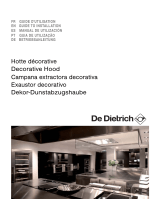3. Assembling the ventilation shaft for ducting outdoors:
a) Operation with evacuation to outdoors
The installation must comply with applicable regulations concerning room ventilation.
In particular, evacuated air must not be transferred through a conduit used to evacuate
fumes from equipment burning gas or similar fuels.
Unused and existing conduits can only be used following approval by a qualified specia-
list.
- Remove the two mounting screws from the plastic deflector (fig.6).
The plastic deflector is only used for an installation in recirculating mode.
- Push the non-return valves (fig.2) into the hood outlet pipe. Remove the adhesive
tape retaining the valves.
- Recover the chimney support plate (fig.3).
- Mount the metal chimney support on the wall, in contact with the ceiling (fig.3).
Check that the two triangular notches are aligned with the vertical line on the wall (drill
dia. 8 mm, two screws and plugs supplied).
- Engage and secure the evacuation duct, dia. 150 mm (not supplied) in the hood outlet
pipe.
- In the case of a duct, dia. 125 mm, use the adapter supplied (fig.4).
- Prepare your telescopic chimney, carefully covering the vents (fig.5).
Push the chimney sections, one into the other, as far as possible.
- Mount the upper part of the inner chimney on the metal support, using the screws
supplied (to facilitate installation, pull the chimney slightly clear, so that the two returns
can be inserted behind the metal support).
- Adjust the length of the chimney by sliding the outer part down and sitting it in the
top of the hood.
Installation recommendations:
For optimum use of your hood, we recommend that it be connected to a duct of
diameter 150 mm. Keep the number of angles and the duct length to a mini-
mum.
If your extractor hood is being used to dispel air outside, make sure your
kitchen has a fresh-air vent so that it does not become deprived of oxygen.
I
n s t a l l i n g y o u r hood
7















